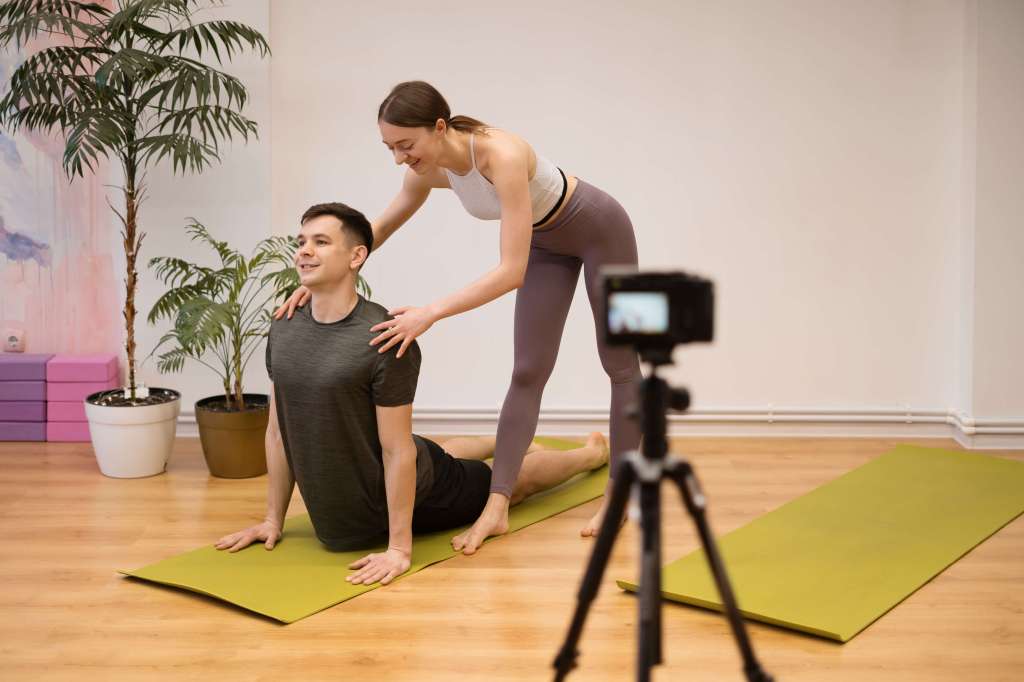If you’re passionate about yoga and want to share this ancient practice with others, read our step-by-step guide on how to become a yoga teacher.
- How to start a business
- Benefits of yoga for stress release – and three practical tips
- A guide to self-employed expenses
- Which bank has the best business bank account?
- What is business insurance?
If you’re wondering what qualifications you need, how to find your niche, and practical matters like how to do your taxes, read our simple guide.
What does a yoga teacher do?
Yoga teachers are usually self-employed and it’ll often be a side hustle around paid employment.
Working in studios and fitness centres, yoga teachers lead classes that provide both physical and mental benefits. Bear in mind that fitness classes are often on weekends and in the evenings, so you’ll need to be flexible with times you teach.
Typical day-to-day activities as a yoga teacher include:
- planning classes to suit a range of abilities
- breathing exercises (pranayama)
- supporting students to progress their practice
- continuing to develop your own skills and knowledge as a yoga teacher
- marketing your classes and building relationships with studios and community groups
With experience you could also teach workshops, retreats, and one-to-one clients.
Yoga teacher training – skills and qualifications
To become a yoga teacher you’ll need to have a consistent home practice yourself before training to teach. It’s a good idea to have at least two years of regular practice, if not more.
When it comes to choosing a yoga teacher course, it can be a little overwhelming with so many options available. A few good questions to ask yourself include:
- where should I study? You could train at a local studio and get to know the yoga community where you hope to teach, or travel overseas to completely immerse yourself in your training without everyday distractions
- what style of yoga am I most interested in? You could choose ashtanga yoga teacher training, yin yoga, aerial yoga, hot yoga – the options are endless, but make sure it’s a style you’re already regularly practicing
- should I choose an intensive yoga teacher training or a part-time course? Intensive courses are usually four to six weeks of daily yoga practice and study, while part-time courses are often completed on weekends over a six to 12 month period
- is the training certified by a professional body? For example Yoga Alliance or British Wheel of Yoga (we’ll explain more on this below)
- how will the training be delivered? Connect with the teacher and find out about the balance of online recordings, live sessions, individual study, and practical elements
How long does it take to become a yoga teacher?
To teach yoga you’ll need to complete a 200-hour yoga teacher training course. This should cover asana (postures), meditation, pranayama (breathing exercises) yoga philosophy, anatomy, physiology, and how to teach.
If you’re looking at a college course in the UK, you could complete a qualification like a:
- Level 3 Diploma in Teaching Yoga
- Level 4 Diploma in Teaching Yoga
With experience you might choose to specialise further by completing pregnancy yoga teacher training or children’s yoga, for example. You could also go on to complete 300-hour and 500-hour teacher training.
Yoga accreditation bodies
There are various professional bodies that set the standards for teacher training courses around the world, including:
Yoga teacher salary
How much yoga teachers earn can vary widely depending on whether you teach at your own home studio or work at different gyms and fitness centres.
You might hire a venue for weekly classes with the benefit of having greater control and keeping the profits, but that comes with greater financial risk. Alternatively, if you work with studios you’ll either be paid by the hour or paid a percentage of the class profits.
Workshops and one-to-one teaching can be more lucrative, so many teachers will offer a combination of these on top of regular studio classes.
How to start a yoga business
1. Decide on your niche
Once you’ve done your yoga teacher training, you can start to explore where your strengths lie and find a gap in the market. Whether that’s appealing to a specific group of people in your community, teaching online workshops, or adding yoga to an existing therapeutic business.
For example, you could teach yoga for employees at local businesses, or you might prefer to set up a charity that supports people to access yoga through community classes and events.

2. Create a business plan and budget
It can be all too tempting to just get out there and teach, but without proper planning you won’t be clear on your direction as a teacher and business owner.
A business plan will be your guide when starting out as a yoga teacher, helping you to understand the market, your competitors, and where and who you’re going to teach.
It’s important to structure your business plan clearly and keep reflecting back on it to make sure you’re meeting your goals. For more, read our guide to writing a business plan for a new business.
3. Work out a legal structure for your yoga business
Yoga teachers are often self-employed as you could be working at a range of fitness centres, studios, and gyms, but also running your own private classes. Many are sole traders, but you might choose to set up a limited company for your yoga business. Our guide on the difference between a sole trader and limited company goes into more detail on this.
One of the first things you need to do is register with HMRC so you can pay your taxes. Here’s a summary of key tax year dates and guidance on how to do your tax return.
4. Build your brand and start marketing
The world of teaching yoga has changed dramatically since the pandemic with many more online classes and the increasing challenge of competing with teachers who offer classes for free.
So how do you stand out from the crowd? Here are a few tips if you’re just starting out.
- create a business website and social channels – make sure your photography and copy represents who you are as a teacher
- partner with other local businesses who can promote your business to their customers – choose a company that reflects your brand’s values, for example a healthy cafe or smoothie bar
- conduct a SWOT analysis of your yoga business to understand your strengths and weaknesses, as well as external opportunities and threats
Read our guide to marketing your small business for more ideas.
5. Organise yoga insurance
While it’s not a legal requirement, many studios and gyms will request proof that you have yoga teacher insurance. Yoga teacher insurance in the UK can include:
- public liability insurance – in case someone is injured or their property is damaged
- business equipment insurance can cover you if your equipment is damaged or stolen
- employers’ liability insurance is a legal requirement if your business grows and you employ one or more people
You might also consider health insurance to cover you if you’re unable to work if you get sick or injured.
6. Understand legal and financial responsibilities
If you play music in class then you’ll need to have a licence – this is called TheMusicLicence.
When it comes to the financial side of your business, it’s helpful to create a budget.
7. Grow your business
If business is going well, you might like to go on to develop and deliver your own teacher training courses. Bear in mind, to be a teacher trainer you need to have completed 500-hour teacher training and five years’ teaching experience.
Opening your own studio could also be an exciting opportunity, whether that’s building a studio in your garden or leasing a space in your community.
Whatever you do in the future, keep an eye on market trends and make sure you’re regularly doing competitor analysis to stay ahead. For example, can you take advantage of the growing popularity of paddle boarding and offer paddle board yoga classes?
Not sure if yoga teaching is for you?
Here are a few other business ideas you might want to consider instead:
Is there anything else you want to know about becoming a yoga teacher? Let us know in the comments.
Insure your yoga business
As one of the UK’s biggest business insurance providers, we specialise in public liability insurance and protect more trades than anybody else. Why not take a look now and build a quick, tailored quote?

This block is configured using JavaScript. A preview is not available in the editor.